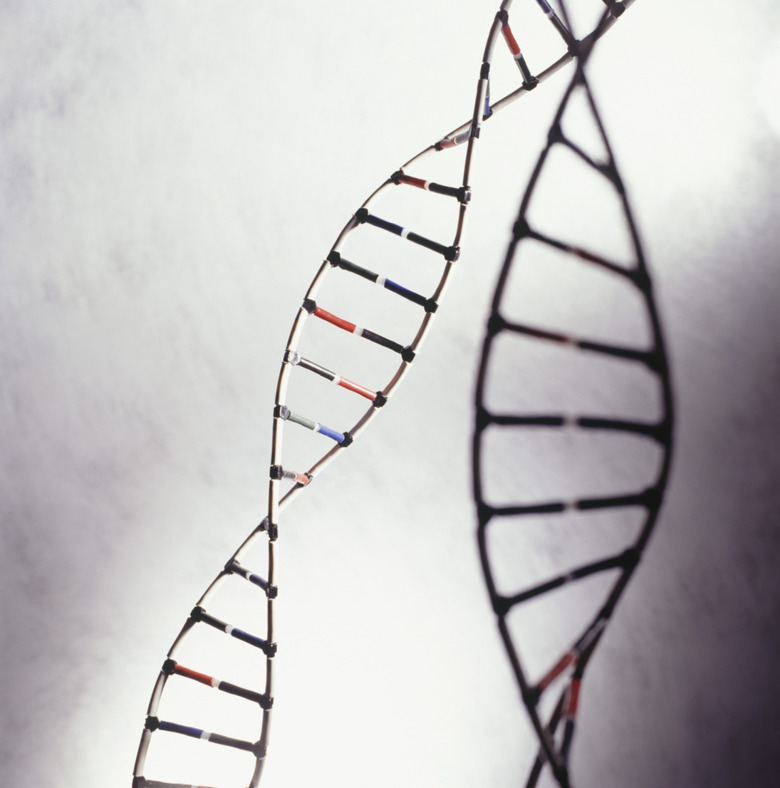What Is The Difference Between Continuous & Discontinuous DNA Synthesis?
The genetic code of living organisms is contained in the DNA of the chromosomes. The DNA molecule is a double helix made up of pairs of _nucleotides_, each consisting of a phosphate group, a sugar group and a nitrogen base. The structure of the nucleotides is asymetrical, meaning that the two strands of the double helix DNA have opposite directions.
When DNA synthesis takes place during DNA replication, the two strands of the double helix are separated. Replication can only take place in the forward direction of each strand. As a result, one strand is copied continuously in the forward direction while the other is copied discontinuously in segments that are later joined.
Why the DNA Strands Have a Direction
Why the DNA Strands Have a Direction
The sides of the double helix DNA molecules are made up of phosphate and sugar groups while the rungs are made up of nitrogenous bases. By convention, the carbon atoms in the carbon chains or rings of organic molecules are numbered in sequence. The carbon atoms in the nitrogenous bases are numbered 1, 2, 3, etc. To distinguish the numbered carbon atoms of the sugar groups, these carbons are numbered using a prime symbol, i.e. 1', 2', 3', etc., or one prime etc.
There are five carbon atoms in the sugar groups, numbered 1' to 5'. The 5' atom has a phosphate group attached to it while the 3' carbon links to an OH group. To form the sides of the helix, the 5' phosphate on one side of the sugar group links to the 3' OH of the next nucleotide. The sequence of this strand is 5' to 3'.
The rungs of the helix molecule are formed from linked nitrogenous bases. The four bases in DNA molecules are adenine, guanine, cytosine and thymine abbreviated as A, G, C and T. The A and T bases can form a link, and G and C can link.
When a nucleotide of the 5' to 3' sequence chain links to another nucleotide to form a rung, the other nucleotide has the opposite phosphate/OH sequence. This means one side of the helix runs in the 5' to 3' direction while the other side runs in the 3' to 5' direction.
Discontinuous DNA Replication Versus Continuous Replication
Discontinuous DNA Replication Versus Continuous Replication
DNA synthesis can only take place when the two strands of the double helix are separated. During DNA replication, an enzyme breaks open the helix and DNA polymerase copies each strand. The strand running in the 5' to 3' direction is called the leading strand while the other strand, with a 3' to 5' sequence, is the lagging strand.
The polymerase can only copy DNA in the **5' to 3' direction.** This means that it can continuously replicate the leading strand as it moves from the initial point of separation along the strand. To copy the lagging strand, the polymerase has to replicate backwards along the strand to the initial point of separation.
Replication then stops, moves up the strand and moves backwards again to the segment that has already been copied. A series of disconnected DNA segment copies called Okazaki fragments are produced from the lagging strand.
DNA Ligase
DNA Ligase
As DNA replication progresses, the DNA ligase enzyme joins the Okazaki fragments into a continuous strand. This combination of continuous synthesis of the leading strand and piecewise or discontinuous replication of the lagging strand results in two new DNA helixes once the segments of the lagging strand have been joined together.
Each new double helix has a parent strand from the original DNA molecule and a newly replicated strand, synthesized by the DNA polymerase. When replication has concluded successfully, there is no difference in the two copies of the original DNA molecule, although one was derived through continuous replication while the other had discontinuous DNA replication.
Cite This Article
MLA
Markgraf, Bert. "What Is The Difference Between Continuous & Discontinuous DNA Synthesis?" sciencing.com, https://www.sciencing.com/difference-between-continuous-discontinuous-dna-synthesis-11415/. 31 July 2019.
APA
Markgraf, Bert. (2019, July 31). What Is The Difference Between Continuous & Discontinuous DNA Synthesis?. sciencing.com. Retrieved from https://www.sciencing.com/difference-between-continuous-discontinuous-dna-synthesis-11415/
Chicago
Markgraf, Bert. What Is The Difference Between Continuous & Discontinuous DNA Synthesis? last modified August 30, 2022. https://www.sciencing.com/difference-between-continuous-discontinuous-dna-synthesis-11415/
